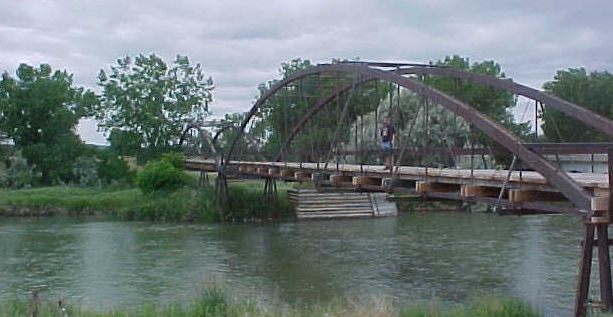
Military Bridge, Fort Laramie, 2001. Photo by
Geoff Dobson.
For discussion and additional photos of the Military Bridge, see Fort Laramie. Opening the line required the construction of swing stations and home stations to
service the stages and their passengers. As indicated by the the photos, most were crude
affairs constructed of logs and sod.
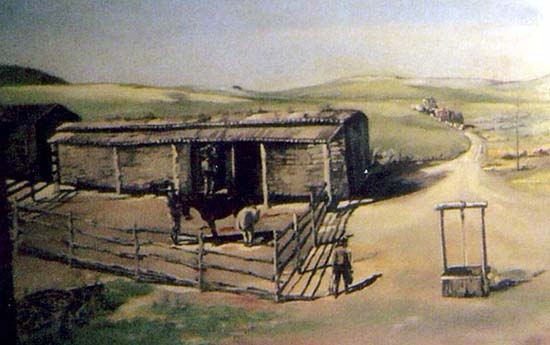
Running Water Station.
As can be seen, the station at Running Water was a soddie. The barn, however,
was more substantial, made of stone but with sod roof.

Changing horses at Running Water Station.
Running Water Station was about 1 1/2 miles west of present day Lusk at Silver Cliff.
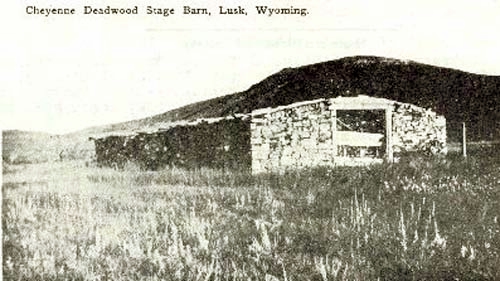
Ruins of Barn at Running Water Station.
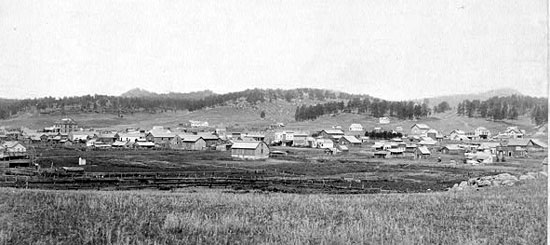
Custer City, 1890, photo by John C. H. Grabill.
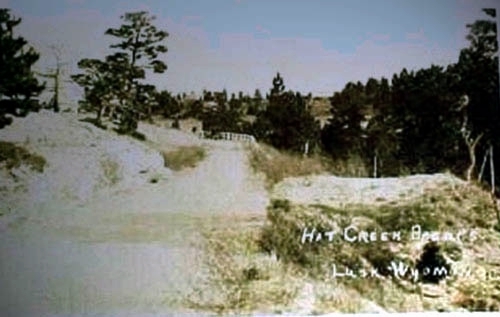
Deadwood Stage Road at Hat Creek Breaks north of
Lusk, undated.
For discussion of the Hat Creek Breaks see Lusk.
Among those who traveled along the stage road was Martha "Calamity"
Jane Cannary Burk, photo below,
who achieved fame and, allegedly, her name as a result of her rescuing
Capt. Egan from
Indians at Goose Creek Camp (now Sheridan).
Unfortunately, Calamity
Jane, as a result of alcoholism
was a continuous calamity. In 1874, she was working at the
Jules Ecoffey and Adolph Cuny hog ranch
five miles west of
Ft. Laramie. Of the hog ranch John G. Bourke (1846-1890), aide de camp to George Crook, wrote:
"Several times, on mild afternoon, Lieut. Schuyeler [sic]* and myself went riding,
taking the best road out from the post. Three miles and there was a nest
of ranches, Cooneys [sic] and Ecoffey's and Wright's*, tenanted by as hardened
and depraved a set of wretches as could be found on the face of the globe.
Each of these establishments was equipped with a rum-mill of the worst
kind and each contained from three to half a dozen Cyprians*, virgins whose
lamps were always burning brightly in expectancy of the upcoming
bridegroom, and who lured to destruction the soldiers of the garrison.
In all my experience, I have never seen a lower, more beastly set of
people of both sexes."
[Writer's notes: Walter S. Schuyler, also an aide de camp to Gen. Crook; Wright's, a bordello
frequented by soldiers from Fort Laramie. Cyprian, a woman of the night, so-called from
Cyprus the birthplace of Aphrodite, the goddess of love.]
If anything, Bourke's comments as to the tenants of the hog ranch being hardened, may
have been an understatement. During the nine-year period 1868-1877, at least 8 denizens of the ranch
died at the hands of others, including two owners, John Hunter, 1868, and Adolph Cuny, 1877.
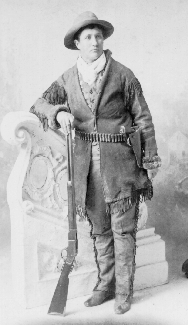 Martha "Calamity"
Jane Cannary Burk
Martha "Calamity"
Jane Cannary Burk
Calamity Jane signed on for several military expeditions as a
bullwacker but was fired
when her gender was discovered. In 1876, she served several terms
in the Cheyenne jail for disturbing the
peace. She then drifted to Deadwood but, after James "Wild Bill" Butler
Hickok's demise at the hand of Jack McCall, continued
to drift. On one stage trip between Custer City and Rock Creek she was
unable to pay her fare and her trunk was retained by the stage line.
It was found to contain only clothes and a photograph of Hickok. Reportedly,
the last place the trunk was seen was in the attic of the pump house at
Ft. Steele.
She ultimately married Clinton Burk in El Paso by whom she had a daughter.
In 1896, after returning to Deadwood, Burk departed town
after embezzling money. Jane's daughter was taken from her
and placed in a convent to be reared by the sisters.
In her
"Autobiography," regarded
today as primarily fiction, she claims to have driven the stage in
after Slaughter's death. However,
Wm. F. Cody, recollected that she told the same story with regard
to a stage driven by one Jack McCall,
allegedly wounded by Indians on the Deadwood to Wild Birch run.
In 1901 Calamity Jane was found ill and
drunk in a Negro parlor house in Horr, Mt. Two years later she died,
delirious, in Terry, S.D with her last words being
of her daughter. Jane is buried near Wild Bill Hickok in the Mount Moriah Cemetery in
Deadwood. This has led to all sorts of rumors about their relationship, all of which are untrue.
As Russell Thorp later indicated, a group of businessmen in Deadwood when they heard that Jane had
died in poverty gathered in Mike Russell's Saloon and decided that in appreciation for her
efforts during the smallpox epidemic they would send her off in fine style. In Thorp's words they also
decided, "Now Wild Bill had absolutely no use for Jane, but
this distinquished, self-appointed committee decided it would be
a good good joke on the old boy to make him
'layup' with her for all eternity."
Deadwood Stage continued on next page.
|